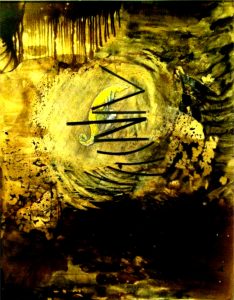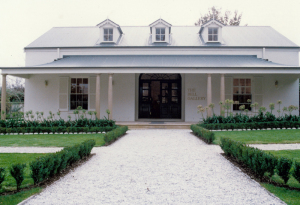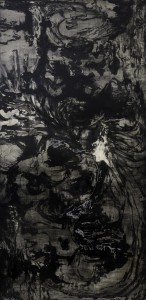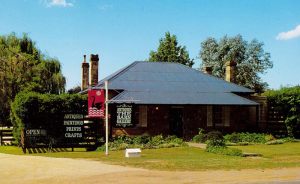Art Achievements: Art Prize Finalist and Retrospective
In 1994 Roberta was invited to hold a retrospective exhibition of her work (1948-1994) to mark the opening of the new Southern Highlands Regional Gallery at Moss Vale.
The following words include some of the history of Roberta’s art career as written about by Robert Wilson and the artist herself.
The sum total of Roberta Bell’s artistic work goes a long way further than the paintings you see hanging on the walls of the Southern Highlands Regional Gallery today. A true retrospective of this very creative person’s life would fill pages. As well as running two very successful art galleries, Roberta has been tireless in her contributions to the community of the Southern Highlands.
But today we are applauding Roberta Bell the painter: an artist of significant talent.

[left] The Endangered 2012, mixed media.
Having commenced her creative career as a designer – first studying, then teaching design at East Sydney Technical College under Phyllis Shillito, it wasn’t until Roberta married Jack Howland in 1960 and moved to Wellington in central NSW, that she really started painting seriously; her first success being Growth of the Amoeba, a mural that was selected as a finalist in the Sulman Prize.
For a ‘city girl’, living in rural NSW was a revelation in itself:
the broad expanse and depth of inky darkness of the central plains at night stirred deep emotions, [Roberta]
Sudden exposure to this new landscape provided the inspiration for paintings like Night on the Pilliga Road which was hung in the Wynne and marked the start of Roberta’s entry into major art competitions in earnest; realising her full potential as a painter.
The culmination of this early period can be seen in The Gossip – highly commended in no less that five major art competitions, proved to be the turning point in her life as a painter. The praise she received for this fine work raised her confidence and convinced her once and for all that her career as a painter was well worth developing. Other significant works painted during this time included: Polaroid, Weird Mob for the Sulman Prize; and Parable of the Sower, which was selected in the Blake Prize finalist exhibition.
As well as painting, Roberta’s other career path, that of gallery owner, was also taking shape. In 1962 she organised the first Wellington Art Prize, which was judged by Roland Wakelin and was won by Margo Lewers.
By 1964 Roberta had moved to Wollongong, which marked another important period in her life as an artist. During this time she produced a series of shellac panels inspired by the strange play of filtered light on the rainforests of Macquarie Pass, with an emphasis on a vertical perspective. These panels were very well received with James Gleeson highly commending them at the Wollongong Art Prize; Kym Bonython showing them in his Paddington gallery; the NSW Water Board purchasing a panel of six, titled Cascade; and overseas recognition with American banker Theodore King purchasing a panel of three.
Impressions of a drought-stricken rural NSW maintain a strong presence in Roberta’s work, especially evident in the heartfelt painting Cambelago Image, Roberta was becoming more and more perceptive of the changes found in new and different surroundings. For example works such as, Steel Heat and Through a Glass Darkly, reached deeply into the industrial landscape of Wollongong, where she and her husband Jack Howland relocated to in 1963. Both paintings were highly commended by Thomas Gleghorn when they were hung in the Wollongong Art Prize.
Because of Roberta’s very deep sense of spirituality, it was only natural for her to examine her religious beliefs through her art. Serpent in the Garden of Eden, a finalist in the Blake Prize was painted specifically for the Prize; the influence of hot, fiery, cascading colours of the furnaces from the steelworks, can be seen working in conjunction with a deeply religious theme to produce a painting of incredible intensity and significance.
Making a Difference: The Growth of the Fine and Decorative Arts Community in the Southern Highlands
With the move to Berrima in 1973, Roberta’s life changed dramatically. A new business, The Barn Gallery, was born and she became increasingly active in the community, being a founding member of the Berrima Business Houses Association and constantly employing her artistic skills to design a multitiude of the Association’s brochures, promotional banners and flags for festival events and special occasions.
However, Roberta still found time to continue her examination of religious themes resulting in several significant works including the very uplifting, And God Divided the Light from the Darkness, painted in 1976 and God’s Promise to Noah, completed in 1977; both of which were finalists in the Blake Prize.
Suddenly and surprizingly in 1978, her husband Jack Howland passed away. There was now even less time for painting as Roberta’s ‘other’ career path, full-time antique dealer and gallery owner, consumed the next 24 years of her life. Over this period Roberta single-handedly organised and held more than 60 exhibitions, including many legendary Christmas shows of important works; from local artists such as Max Miller and James Luck, to internationally renowned artists like John Coburn, Arthur Boyd, David Boyd, Charles Blackman, Robert Dickerson, Doreen Gadsby, Peter Hickey, Sidney Nolan, Brett Whiteley, Margaret Woodward, Pro Hart and Hugh Sawrey. Roberta’s exhibitions always featured the very best male and female artists that Australia had to offer. Roberta also exhibited works by Sidney Nolan and British artists Victor Passmore, Graham Sutherland and John Piper, purchased from Marlborough Fine Art in London. Her aim was to put Berrima on the art-world map, nurturing and educating a local audience as well as attracting metropolitan and overseas visitors to the Southern Highlands.

The Bell Gallery
With the sale of the land that The Barn Gallery occupied in the late 1980s, the planning, designing and building of what was to become, without doubt, one of Roberta’s crowning achievements, The Bell Gallery was launched, culminating in its grand opening by John Hewson in 1990. The oil painting Celebration, resulted as an evocation of this joyous and productive time.
Official recognition for The Bell Gallery came in 1992 when Roberta won the New South Wales Tourism Award for Excellence. This award was given for The Bell Gallery’s ‘outstanding contribution to cultural tourism in NSW’.
As well as completing several works in the early 1990s including Glebe II, Bushfire and Horizon III, Roberta varied her medium, designing and painting an inspired collection of eight Spanish-pine carousel-horses as well as painting thirty, very popular wooden icons.
Despite her business commitments and community activities, Roberta’s creative spirit drives her to keep on painting.






